-
PESQUISA01/01/2018
Being born at home is natural: care rituals for home birth
Revista Brasileira de Enfermagem. 2018;71:1247-1256
Resumen
PESQUISABeing born at home is natural: care rituals for home birth
Revista Brasileira de Enfermagem. 2018;71:1247-1256
DOI 10.1590/0034-7167-2017-0541
Visualizações0Ver maisABSTRACT
Objective:
To be aware of the care rituals developed by families when preparing for home birth during the gestational process.
Method:
Qualitative and ethnographic research developed with families during the gestational process. We adopted the observation-participation-reflection model, and the analysis was performed according to ethnonursing.
Results:
Care rituals are related to the choice of home as a place for childbirth, being characterized as a family’s rite of separation to experience this process. Other care rituals involved the preparation of the family and the eldest child as well as the home, the body, and the mind of the pregnant woman, and the choice of destination of the placenta.
Final considerations:
We must understand the birth process beyond the biological perspective, considering women and their family as a whole, within a cultural context with their beliefs and values.
-
PESQUISA01/01/2018
Violence against children and adolescents: profile and tendencies resulting from Law 13.010
Revista Brasileira de Enfermagem. 2018;71:1237-1246
Resumen
PESQUISAViolence against children and adolescents: profile and tendencies resulting from Law 13.010
Revista Brasileira de Enfermagem. 2018;71:1237-1246
DOI 10.1590/0034-7167-2017-0048
Visualizações0Ver maisABSTRACT
Objective:
Describing the profile of reported violence against children and adolescents and draw an essay on the initial effects of Law 13.010 on report patterns.
Method:
Analytic study of reported cases on SINAN – Information System on Reportable Harms (from 2013 to 2015) of violence to individuals under 19, in 53 cities of Minas Gerais.
Results:
1,481 cases were reported, 49.2% before and 50.8% after Law 13.010 came to force (p = 0.5501). There was a 7% decrease on female reports and a 27.2% in male reports (p = 0.0055). It was noticed a change in report patterns (p = 0.0023), with a 130.7% increase to neglect/abandonment reports and a 33% decrease to sexual abuse report. Higher rates of violence from the parents happens at the 1 to 9-year-old age group (p < 0.0001).
Conclusion:
Main victims were women, individuals from 15 to 19 years, with aggression happening within the household; after Law 13.010, changes to patterns of victim and offender profiles and of kind of violence were noticed.
-
PESQUISA01/01/2018
Every birth is a story: process of choosing the route of delivery
Revista Brasileira de Enfermagem. 2018;71:1228-1236
Resumen
PESQUISAEvery birth is a story: process of choosing the route of delivery
Revista Brasileira de Enfermagem. 2018;71:1228-1236
DOI 10.1590/0034-7167-2016-0497
Visualizações0Ver maisABSTRACT
Objective:
To analyze the discourses on the choice of the route of delivery from the perspective of women and health professionals in a public network.
Method:
The methodological approach is the discourse analysis. The data collection was through interviews and the treatment of the data was based on discourse analysis.
Results:
The categories were: 1- Between the preference and the decision there is no choice; 2- The complexity of the choice of the route of delivery; 3- It is necessary to legitimize the choice of the woman.
Final considerations:
From the perspective of women in labor the route of delivery is determined by the physician and women are not proactive. The nurses’ performance is timid, although their presence is fundamental for stimulating the physiological delivery and promoting the autonomy of women. It identifies the need for the physician to adopt a welcoming attitude, informing the women about the pros and cons involved in choosing the route of delivery.
-
PESQUISA01/01/2018
Family violence against gay and lesbian adolescents and young people: a qualitative study
Revista Brasileira de Enfermagem. 2018;71:1220-1227
Resumen
PESQUISAFamily violence against gay and lesbian adolescents and young people: a qualitative study
Revista Brasileira de Enfermagem. 2018;71:1220-1227
DOI 10.1590/0034-7167-2017-0307
Visualizações0Ver maisABSTRACT
Objective:
To analyze the experiences of gay and lesbian adolescents and young people in the process of revealing sexual orientation to their families.
Method:
A qualitative study carried out in a city in the state of São Paulo. Twelve gay and lesbian adolescents and youngsters participated. For the data collection, the semi-structured interview was used and data analysis was performed using the method of interpretation of the senses.
Results:
The family reactions in the process of “coming out of the closet” of the participants were violent, with persecution and even expulsion from home, in addition to the repression of expressions of homoerotic experiences, which impacted on their health and quality of life.
Final considerations:
The family is an essential component of the support network, but also a space that can generate and reproduce forms of violence in the name of heteronormativity. Health services should develop care practices and care for the family and adolescent and homosexual youth victim of violence.
-
PESQUISA01/01/2018
Network to combat violence against rural women: articulation and communication of services
Revista Brasileira de Enfermagem. 2018;71:1212-1219
Resumen
PESQUISANetwork to combat violence against rural women: articulation and communication of services
Revista Brasileira de Enfermagem. 2018;71:1212-1219
DOI 10.1590/0034-7167-2017-0044
Visualizações0Ver maisABSTRACT
Objective:
to identify the constituent services of the network to combat violence against rural women in municipalities in the northwestern region of Rio Grande do Sul and to analyze the articulation and communication of services in search of the resolution of situations of violence.
Method:
descriptive-exploratory, qualitative study, carried out through semi-structured interviews with 26 professionals from intersectoral services, as well as managers and/or those responsible for these services. Data were systematized through content analysis.
Results:
although the professionals collectively discuss and plan coping actions, difficulties were identified in the approximation between services, related to the definition of flow, knowledge of actions/referrals, fear of seeing and reporting violence, understanding that it is not a question of demand of their field of action, and women’s access to services.
Final considerations:
it is evident the need to implement public policies that address the singularities of violence against women in rural settings.
-
PESQUISA01/01/2018
Clinical application of the Standard Operating Procedure of Positioning with Premature Infants
Revista Brasileira de Enfermagem. 2018;71:1205-1211
Resumen
PESQUISAClinical application of the Standard Operating Procedure of Positioning with Premature Infants
Revista Brasileira de Enfermagem. 2018;71:1205-1211
DOI 10.1590/0034-7167-2016-0674
Visualizações0Ver maisABSTRACT
Objective:
To compare the physiological and behavioral responses of Premature Infant (PREEMIE) positioned by the Unit Routine Decubitus (URD) and the Standard Operating Procedure (SOP).
Method:
A quasi-experimental comparative study performed at a Neonatal Intensive Care Unit in Southern Brazil. We evaluated 30 PREEMIEs with gestational age ≤32 weeks, randomly assigned to Unit Routine Decubitus (URD) and Intervention Group (IG), subdivided into Right Lateral Decubitus (RLD), Dorsal Decubitus (DD), Left Lateral Decubitus (LLD) and Ventral Decubitus (VD). It was evaluated before, during and after the procedure: Heart Rate (HR); Respiratory Frequency (RF); Peripheral Oxygen Saturation (SpO2); behavior by the Neonatal Behavioral Assessment Scale (NBAS); by NIPS.
Results:
During the intervention, RR (p = 0.023), indexes in NBAS (p = 0.01) and NIPS (p <0.0001) reduced significantly in SOP. HR and SpO2 did not present a significant difference.
Conclusion:
Positioning according to the SOP shows benefit in relation to the behavioral and physiological status of PREEMIE.
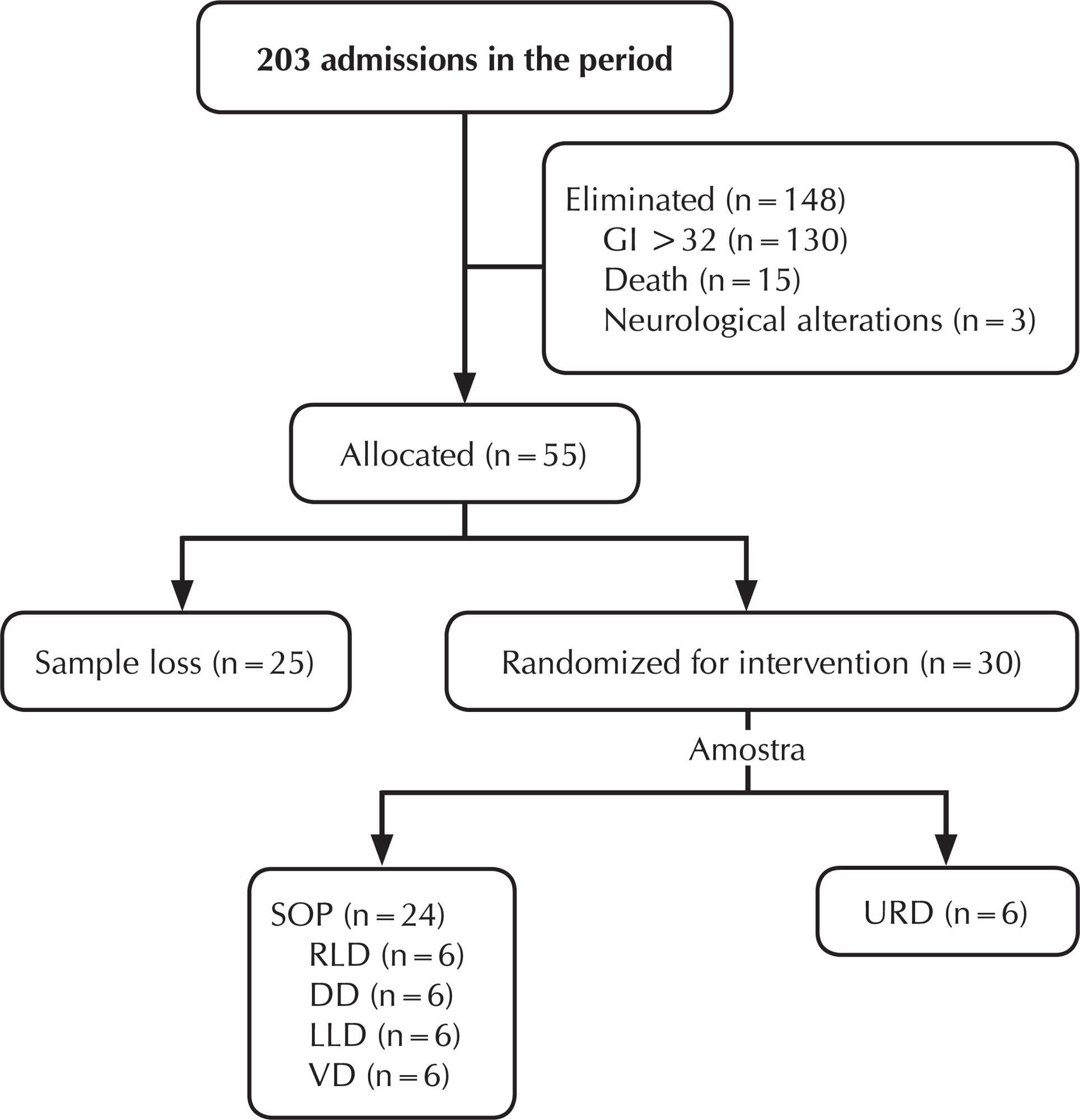
-
01/01/2018
Contribuciones del cuidado en enfermería a la mujer
Revista Brasileira de Enfermagem. 2018;71:1203-1204
Resumen
Contribuciones del cuidado en enfermería a la mujer
Revista Brasileira de Enfermagem. 2018;71:1203-1204
DOI 10.1590/0034-7167-201871sup301
Visualizações0La situación de la mujer y, en particular, los problemas que se refieren a su vida vienen mereciendo destacada atención por parte de los profesionales de la salud, de la sociedad y de los medios de comunicación. Es enfocada por ellos la necesidad de acelerar cambios en la condición que ella ocupó por décadas y […]Ver mais -
01/01/2018
Contribuições do cuidado em enfermagem à mulher
Revista Brasileira de Enfermagem. 2018;71:1203-1204
Resumen
Contribuições do cuidado em enfermagem à mulher
Revista Brasileira de Enfermagem. 2018;71:1203-1204
DOI 10.1590/0034-7167-201871sup301
Visualizações0A situação da mulher e, particularmente, os problemas que dizem respeito à sua vida vêm merecendo destacada atenção por parte dos profissionais de saúde, da sociedade e dos meios de comunicação, sendo focalizada por eles a necessidade de acelerar mudanças na condição que ela ocupou por décadas e ainda hoje ocupa.O ciclo gravídico-puerperal talvez seja […]Ver mais
-
ARTÍCULO ORIGINAL13/12/2019
Uso de tecnologia móvel para o cuidado gestacional: avaliação do aplicativo GestAção
Revista Brasileira de Enfermagem. 2019;72:266-273
Resumen
ARTÍCULO ORIGINALUso de tecnologia móvel para o cuidado gestacional: avaliação do aplicativo GestAção
Revista Brasileira de Enfermagem. 2019;72:266-273
DOI 10.1590/0034-7167-2018-0641
Visualizações0RESUMO
Objetivo:
avaliar o aplicativo GestAção, com base na experiência de uso das gestantes.
Método:
estudo de natureza avaliativa, aplicada, metodológica, com abordagem quanti-qualitativa. A ferramenta tecnológica foi avaliada por 13 gestantes por meio de questionários para a caracterização do perfil sociodemográfico e o uso da escala de Likert, para calcular o Índice de Validade de Conteúdo (IVC) do aplicativo; e entrevista semiestruturada, com análise fundamentada na Semiótica.
Resultados:
o estudo evidenciou significativo nível de satisfação das gestantes com o uso do aplicativo, considerando os objetivos (IVC= 0,92), estrutura e apresentação (IVC= 0,86), e relevância (IVC= 0,92).
Considerações finais:
o aplicativo GestAção obteve IVC geral de 0,90, evidenciando-o como tecnologia facilitadora e coadjuvante no empoderamento das gestantes interessadas em obter conhecimentos sobre o período gravídico, mostrando-se uma potente ferramenta para qualificar as boas práticas na consulta de enfermagem.
Palavras-chave: Aplicativos MóveisCuidados de EnfermagemGestaçãoPromoção da SaúdeTecnologia em SaúdeVer mais -
ARTÍCULO ORIGINAL17/02/2020
Estresse ocupacional em profissionais de enfermagem de um hospital universitário
Revista Brasileira de Enfermagem. 2020;73(2):e20180997
Resumen
ARTÍCULO ORIGINALEstresse ocupacional em profissionais de enfermagem de um hospital universitário
Revista Brasileira de Enfermagem. 2020;73(2):e20180997
DOI 10.1590/0034-7167-2018-0997
Visualizações0RESUMO
Objetivos:
Identificar a presença de estresse ocupacional nos profissionais de enfermagem de um hospital universitário do interior de Minas Gerais e analisar a influência das características sociodemográficas e ocupacionais neste agravo.
Métodos:
Estudo transversal, exploratório e quantitativo, realizado com 124 profissionais de enfermagem de um hospital universitário do interior de Minas Gerais. Para sua efetivação, foi utilizada a versão adaptada e validada para o português da escala Job Stress Scale (JSS).
Resultados:
A maioria dos profissionais era mulheres (87,9 %), com média de idade de 40,2 anos, 80,6 % eram técnicos de enfermagem e 71,8% da amostra apresentava algum grau de exposição ao estresse ocupacional.
Conclusões:
O índice de estresse ocupacional foi superior ao observado em estudos anteriores. Os dados obtidos no estudo apontam para a necessidade de implementar medidas institucionais de prevenção ao estresse ocupacional, sobretudo fortalecendo o apoio social no trabalho.
Palavras-chave: Equipe de EnfermagemEstresse OcupacionalHospital UniversitárioProfissionais de EnfermagemSaúde do TrabalhadorVer mais -
REFLEXIÓN01/07/2020
Como traduzir o conhecimento científico à prática? Conceitos, modelos e aplicação
Revista Brasileira de Enfermagem. 2020;73(5):e20190179
Resumen
REFLEXIÓNComo traduzir o conhecimento científico à prática? Conceitos, modelos e aplicação
Revista Brasileira de Enfermagem. 2020;73(5):e20190179
DOI 10.1590/0034-7167-2019-0179
Visualizações0RESUMO
Objetivos:
apresentar o conceito de Tradução e Intercâmbio do Conhecimento tal como vem sendo utilizado na literatura internacional e, em particular, no Canadá. A seguir, descrever um renomado modelo conceitual para orientar a sua implementação, intitulado Ciclo do Conhecimento à Ação.
Resultados:
ilustramos a utilização do modelo no contexto do sistema municipal de atenção básica à saúde no sul do Brasil, na implementação de estratégias de manejo da dor durante a vacinação.
Conclusões:
nesta reflexão teórica, argumentamos sobre a importância de se traduzir o conhecimento científico aos diversos contextos de prática e criar oportunidades de intercâmbio com os usuários desse saber, como profissionais de saúde, gestores, formuladores de políticas públicas, pacientes, familiares e demais grupos de interesse, para promover equidade e qualidade dos cuidados no Sistema Único de Saúde.
Palavras-chave: Competência ClínicaDifusãoDisseminação de InformaçãoTradução do ConhecimentoTranslaçãoVer mais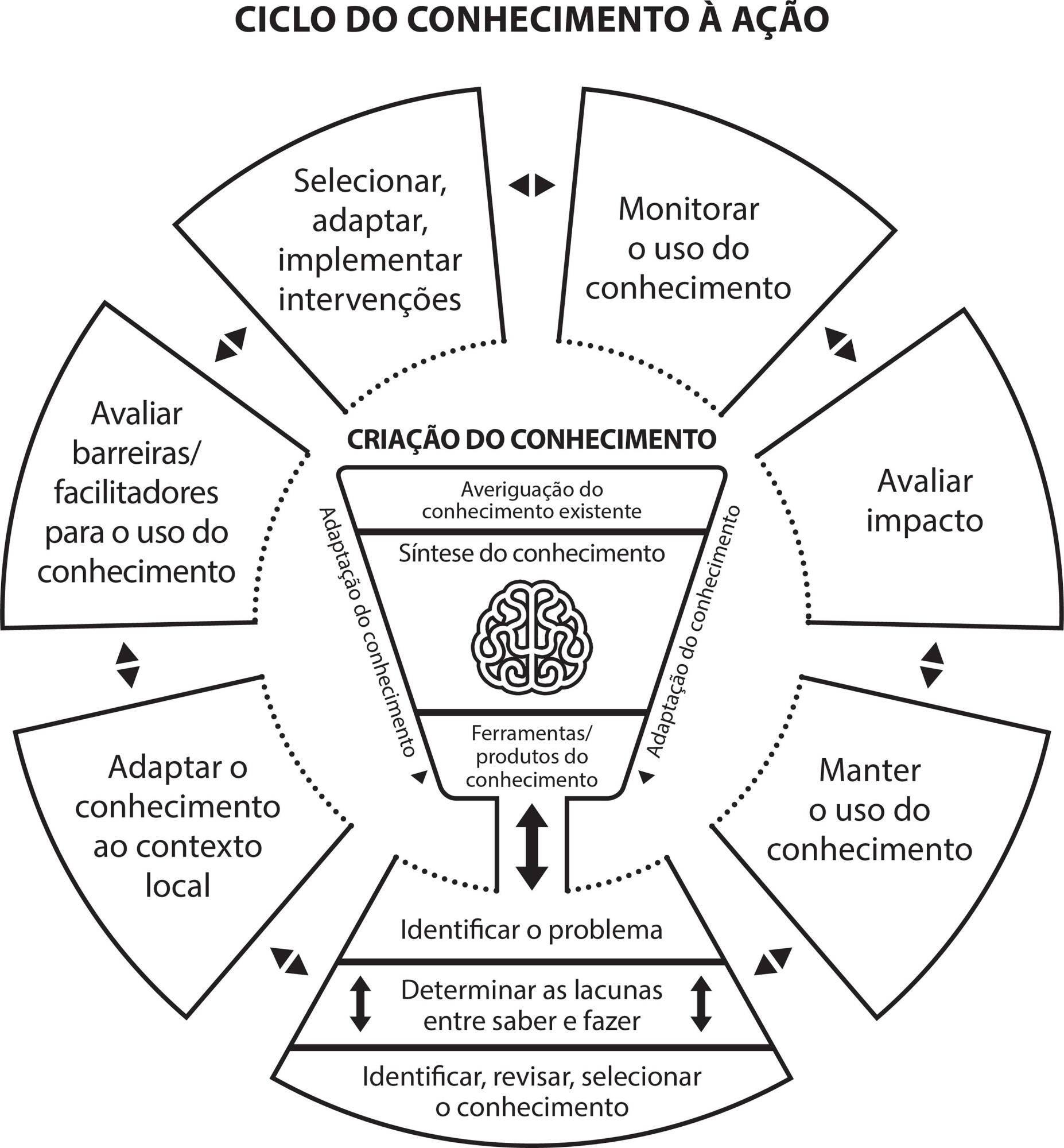
-
REFLEXIÓN05/03/2021
Trabalho do enfermeiro no contexto da pandemia de COVID-19
Revista Brasileira de Enfermagem. 2021;74:e20200594
Resumen
REFLEXIÓNTrabalho do enfermeiro no contexto da pandemia de COVID-19
Revista Brasileira de Enfermagem. 2021;74:e20200594
DOI 10.1590/0034-7167-2020-0594
Visualizações0Ver maisRESUMO
Objetivo:
Refletir sobre o trabalho experienciado pelo enfermeiro no enfrentamento da pandemia de COVID-19 vivenciado em um hospital público do estado do Rio Grande do Norte.
Métodos:
Ensaio reflexivo embasado na vivência profissional em um hospital público de referência para atendimento de pacientes acometidos pela COVID-19 no estado do Rio Grande do Norte. Os resultados foram organizados em duas categorias empíricas, que destacam as potencialidades e entraves do trabalho do enfermeiro diante da COVID-19, apresentados por meio do diagrama de Ishikawa.
Resultados:
Duas categorias emergiram das experiências vivenciadas: Protagonismo da enfermagem na organização dos serviços de saúde para o enfrentamento da COVID-19; e O exercício da gerência dos cuidados de enfermagem na pandemia de COVID-19.
Considerações finais:
Necessita-se valorizar o trabalho do enfermeiro em todos os seus atributos, bem como fortalecer os processos de trabalho interdisciplinares, que colaboram para a superação da crise ocasionada pela pandemia.
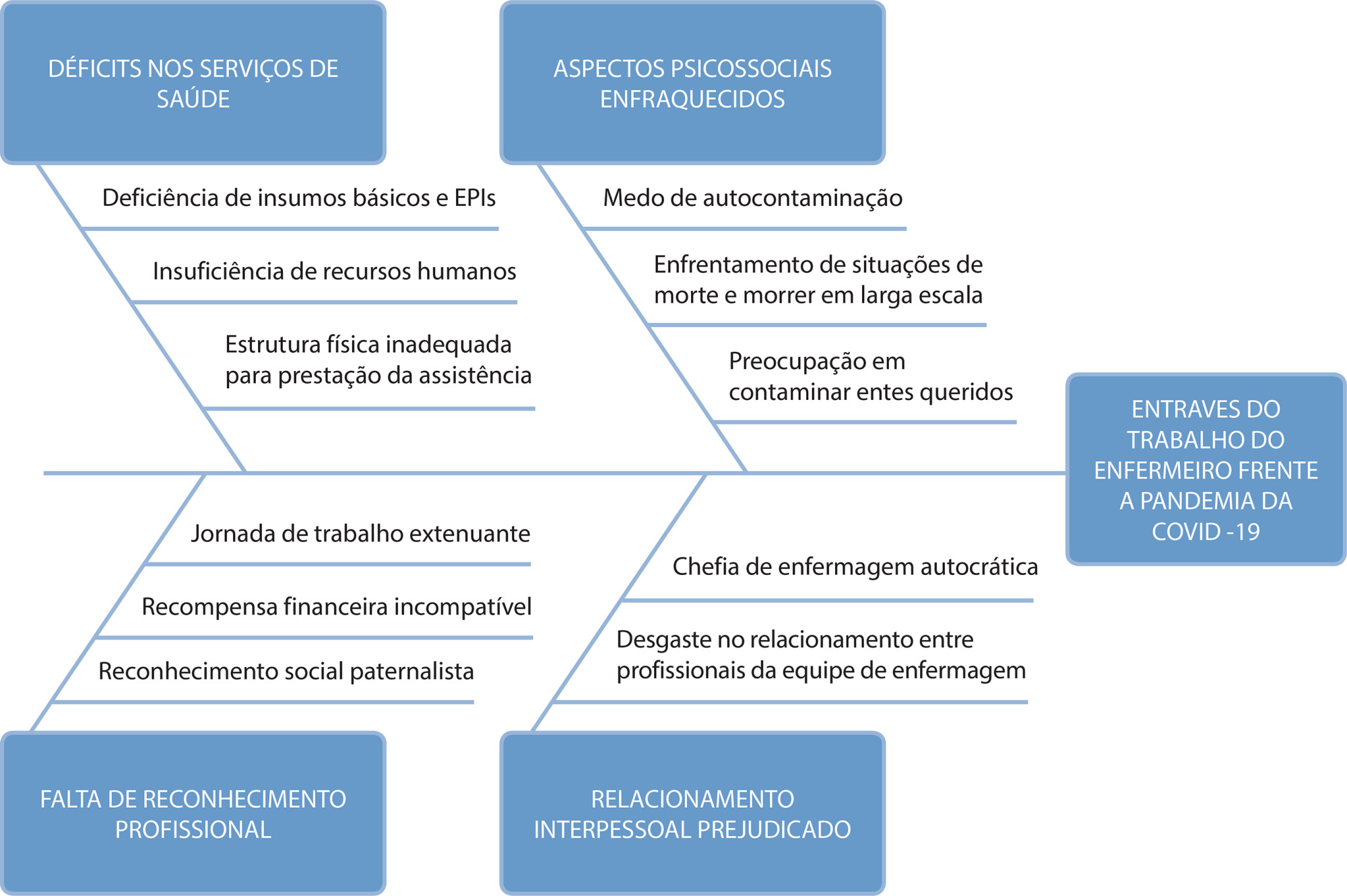
-
ARTÍCULO ORIGINAL08/07/2020
Construção e validação de protocolo assistencial de enfermagem com intervenções educativas para cuidadores familiares de idosos após Acidente Vascular Cerebral
Revista Brasileira de Enfermagem. 2020;73:e20180894
Resumen
ARTÍCULO ORIGINALConstrução e validação de protocolo assistencial de enfermagem com intervenções educativas para cuidadores familiares de idosos após Acidente Vascular Cerebral
Revista Brasileira de Enfermagem. 2020;73:e20180894
DOI 10.1590/0034-7167-2018-0894
Visualizações0Ver maisRESUMO
Objetivo:
construir e validar o conteúdo de um protocolo assistencial de enfermagem com intervenções educativas para cuidadores familiares de idosos após Acidente Vascular Cerebral.
Métodos:
estudo metodológico conduzido em três etapas: (1) construção do protocolo por meio de revisão da literatura; (2) pré-teste com equipe multiprofissional, analisado com articulação da literatura; (3) validação do protocolo pela Técnica Delphi.
Resultados:
o protocolo foi estruturado nos domínios: Orientações Sobre a Doença; Suporte Emocional; Utilização da Rede de Atenção à Saúde; Alimentação; Vias Aéreas; Medicações; Higiene; Cuidados com a Pele; Eliminações; Vestir/Despir; Posicionamento e Transferência; Prevenção de Quedas. No pré-teste, oito especialistas avaliaram a clareza e o conteúdo do protocolo. Na validação, houveram duas rodadas pela Técnica Delphi. O protocolo validado foi composto por 12 domínios contendo 42 itens e 240 orientações de cuidados.
Conclusão:
o protocolo qualifica a transição do cuidado após alta hospitalar auxiliando os enfermeiros na prática assistencial no domicílio.
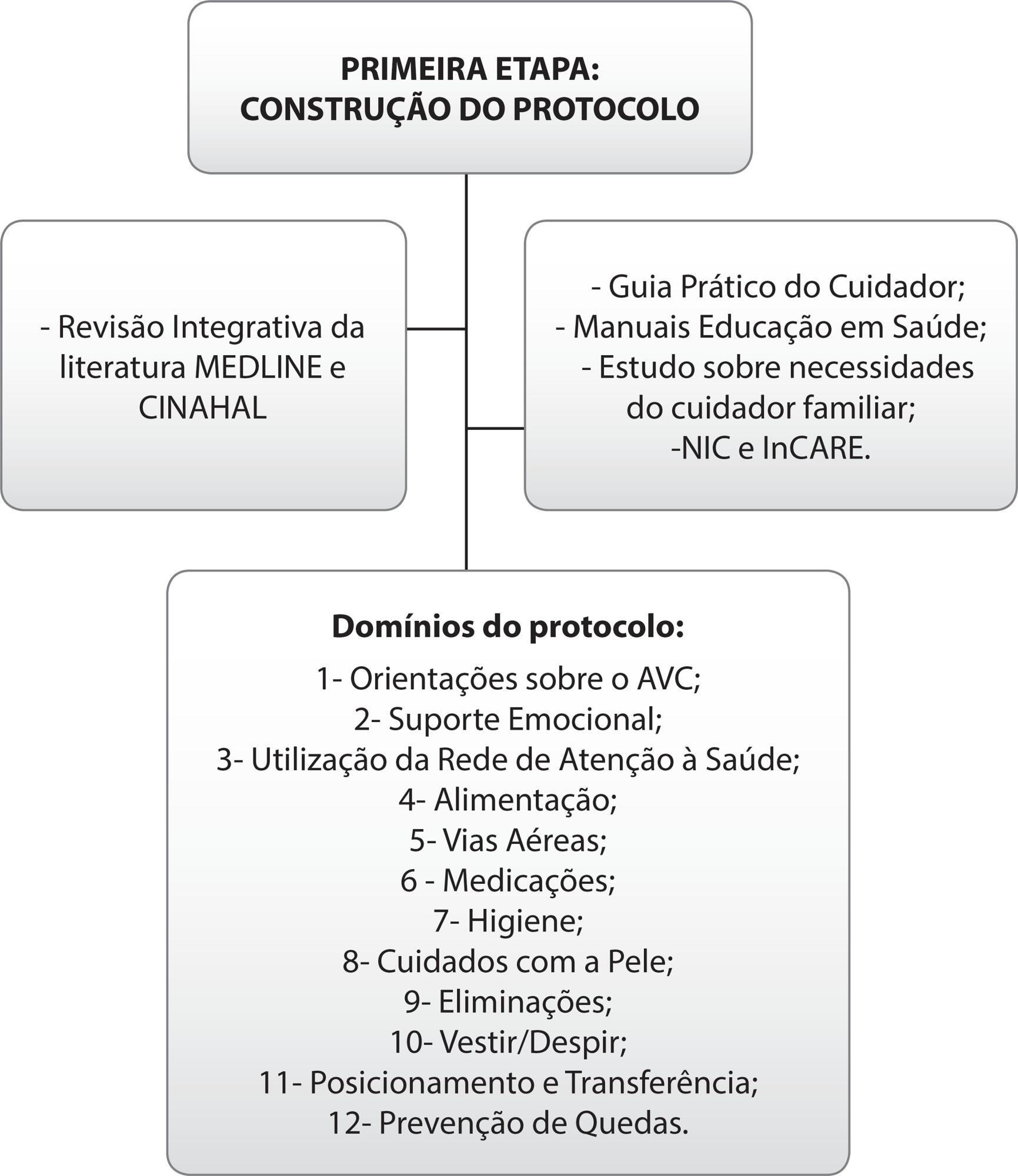
-
ARTÍCULO DE REVISIÓN22/04/2020
Polycyclic aromatic hydrocarbons and development of respiratory and cardiovascular diseases in workers
Revista Brasileira de Enfermagem. 2020;73(3):e20180965
Resumen
ARTÍCULO DE REVISIÓNPolycyclic aromatic hydrocarbons and development of respiratory and cardiovascular diseases in workers
Revista Brasileira de Enfermagem. 2020;73(3):e20180965
DOI 10.1590/0034-7167-2018-0965
Visualizações0Ver maisABSTRACT
Objectives:
to identify the scientific evidence on the development of cardiovascular and respiratory diseases due to workplace contamination by polycyclic aromatic hydrocarbons.
Methods:
integrative literature review. The search for primary articles was held in October 2017 in the Medical Literature Analysis and Retrieval System Online (through Pubmed), Web of Science and Latin American and Caribbean Literature in Health Sciences (LILACS).
Results:
the 16 studies analyzed showed that exposure to polycyclic aromatic hydrocarbons was associated with cardiovascular diseases, such as increased blood pressure, heart rate variation, and ischemic heart disease; and respiratory disorders, such as decreased lung function, chronic obstructive pulmonary disease, asthma, wheeze, coughing, pulmonary wheezing, chest tightness, effort dyspnea, and sore throat.
Conclusions:
polycyclic aromatic hydrocarbons cause deleterious effects on the cardiovascular and respiratory systems through mutations and cellular inflammation, being a risk to exposed individuals.
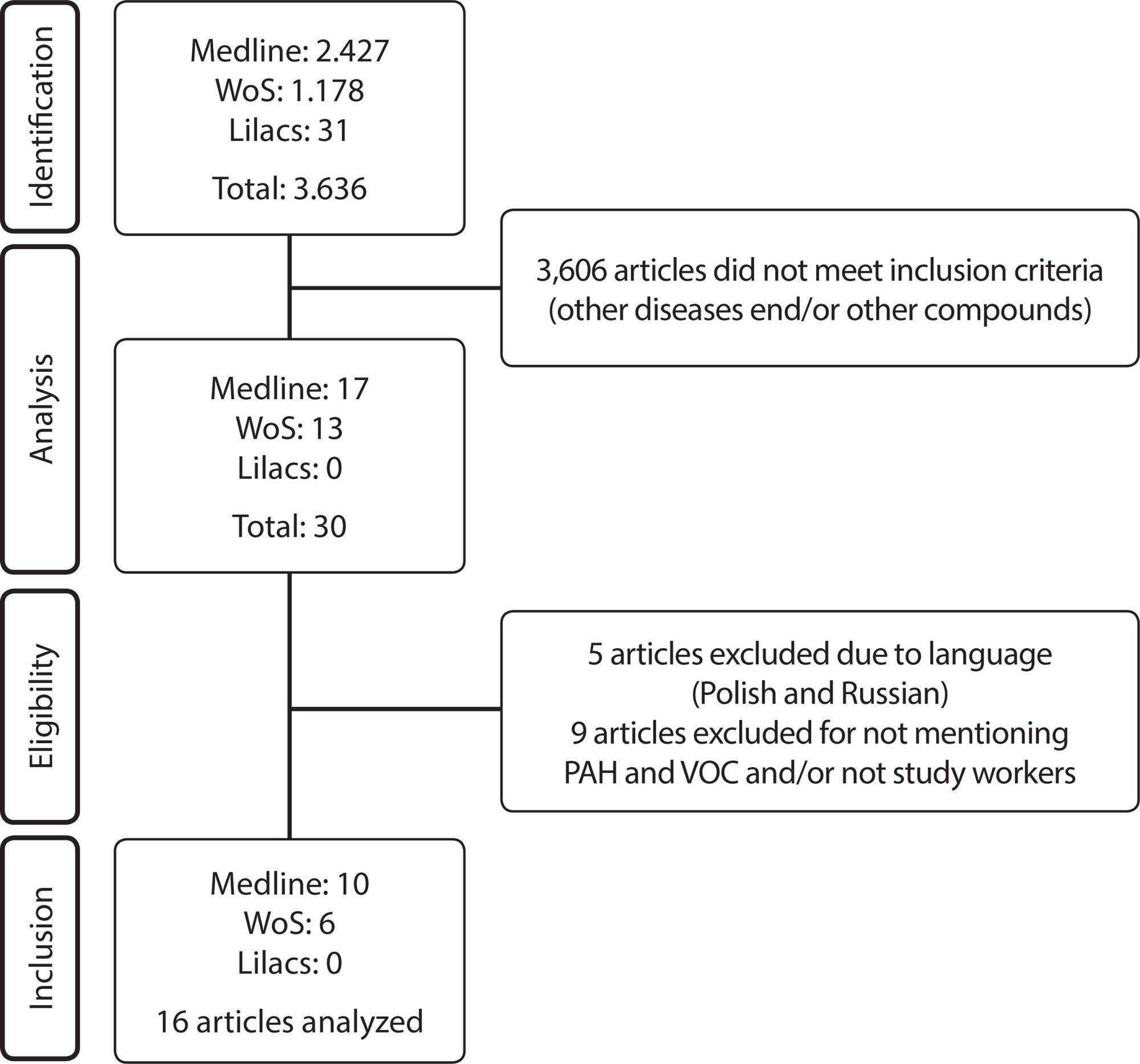
-
ARTÍCULO ORIGINAL23/10/2020
Building and validating an educational video for elderly individuals about fall risks
Revista Brasileira de Enfermagem. 2020;73:e20200010
Resumen
ARTÍCULO ORIGINALBuilding and validating an educational video for elderly individuals about fall risks
Revista Brasileira de Enfermagem. 2020;73:e20200010
DOI 10.1590/0034-7167-2020-0010
Visualizações0Ver maisABSTRACT
Objective:
to build and validate educational video for elderly individuals about fall risks.
Methods:
methodological study with video building. validated by 22 judges and assessed by 22 elderly individuals. Content was selected from the Fall Prevention Model and items from the Falls Risk Awareness Questionnaire. Items with an agreement greater than 0.80 were considered valid. verified through Content Validation Index (CVI) and binomial test.
Results:
building the video was guided by the Cognitive Theory of Multimedia Learning. Digital animation and audio narration were used. It lasted ten minutes and five seconds and included biological. socioeconomic. behavioral and environmental risks as well as precautions to avoid them. The CVI of judges had an average of 0.99. and of elderly individuals. an average of 1.0.
Conclusion:
the video was built and validated for content and understanding and can be used to prevent falls in elderly individuals.
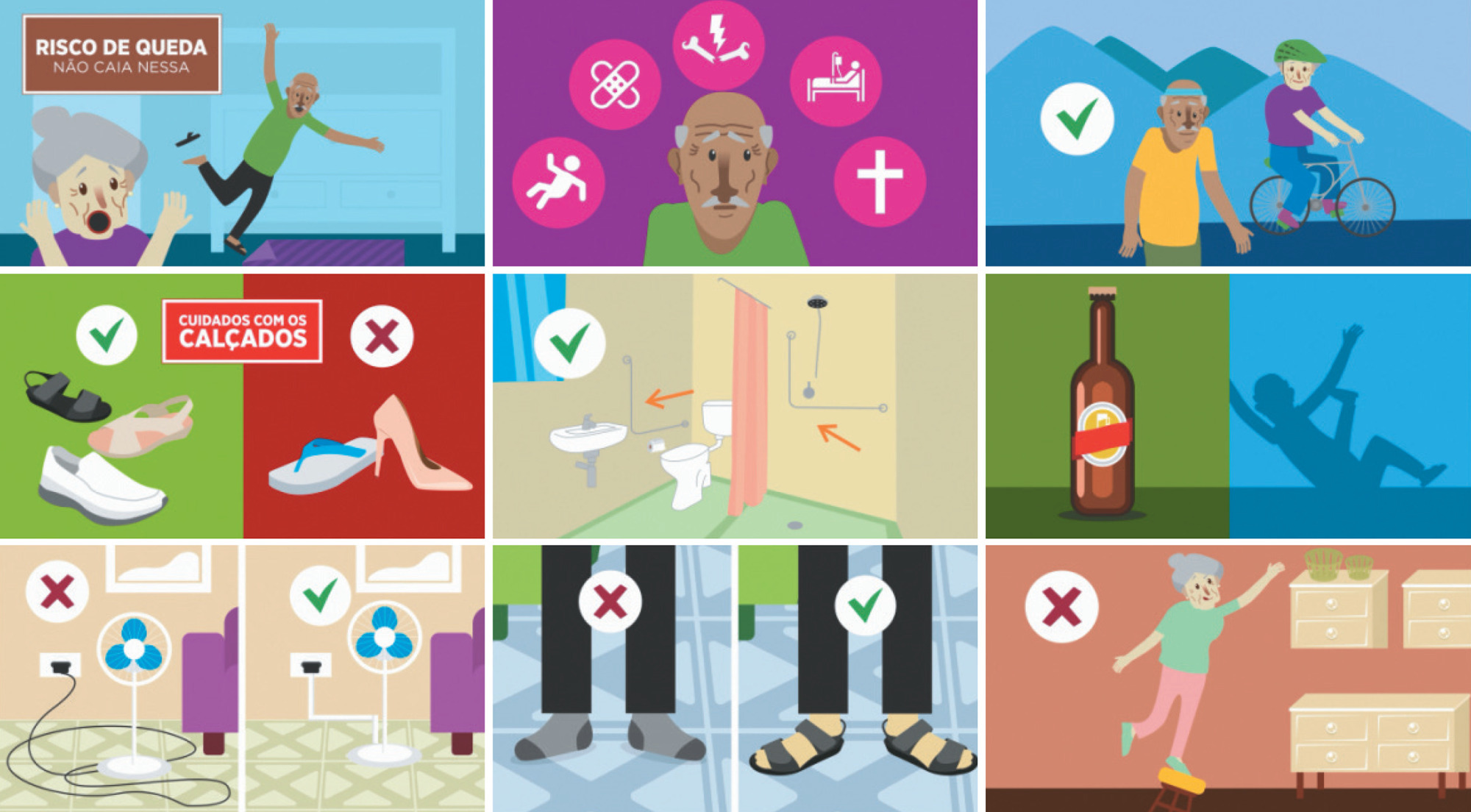
Búsqueda
Buscar en:
Nuvem de Tags
Adolescente (85) Atenção Primária à Saúde (239) COVID-19 (91) Criança (91) Cuidados de Enfermagem (269) Educação em Enfermagem (151) Educação em Saúde (139) Enfermagem (930) Enfermagem Pediátrica (86) Estudantes de Enfermagem (77) Estudos de Validação (131) Família (87) Idoso (208) Promoção da Saúde (99) Qualidade de Vida (104) Saúde do Trabalhador (86) Saúde Mental (145) Saúde Pública (82) Segurança do Paciente (150) Tecnologia Educacional (100)



